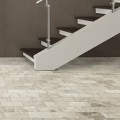Top 13 Slate Tile FAQs
1. What is slate?
Slate is a type of fine-grained, foliated rock that’s formed by the metamorphosis of shale. This stone is mainly made up of clay minerals or micas, depending on the amount of heat and pressure it’s been subjected to; clay minerals in shale change into micas with increasing levels of heat and pressure. The changes fostered by the heat of the Earth’s crust make its surface smooth and flat.
Slate can also contain a significant amount of quartz, along with lesser amounts of feldspar, calcite, pyrite, hematite, and other minerals. The color of slate is generally determined by the amount and type of iron and organic materials present in the rock. Most slates are gray in color, but they also occur in green, red, black, purple and brown.
2. Is slate tile suitable for the floor?
Quality slate tile is incredibly durable and provides a uniquely beautiful look, making it a great choice for flooring installations. Its natural cleft, slightly rough surface provides slip-resistance for a level of safety for your space.
3. What do both sides of slate look like?
The natural structure of slate allows it to split evenly along cleft lines. It also provides an easy determination of top and bottom. During the manufacturing phase, a machine calibrates the side without the cleft line to manage thickness.
4. How thick are slate tiles?
The standard thickness of slate tile ranges between 1/8″ to 1/4″, but there’s a great deal of variation due to the nature of the substance. The thickness of a tile can vary from edge to edge since the surface’s natural cleft has high and low points.
Also, 1/2″ tile may work better in certain instances with heavy foot traffic, because thicker tile is stronger. You’ll pay more since more material is required, though.
5. How much extra material should I purchase for installation?
You’ll want to purchase at least 10% to 15% more material than the job requires for two reasons. The first is that the uneven, unpredictable nature of slate dictates that some material gets wasted during the install. You’ll have to perform cuts depending on the style of slate flooring you choose. The cuts you make to keep the design parallel will lead to bisected tiles that you can’t use fully. Often, 10% extra is recommended for square settings, while 15% extra is recommended for diagonal settings. If you plan on making special designs with slate, even more should be considered.
The second reason is that if your tile chips or breaks over time, you’ll need to replace it. Since tile styles change over time, the only way to guarantee matching tile for the broken piece is by purchasing extra prior to installation.
6. How much do the dimensions of slate tile vary?
While slate tile sizes are often listed in imperial units, they are cut to international metric sizes. This means the actual cut sizes can vary slightly from the listed measurement; for example, 12″x12″ = 300mm x300mm, 16″x16″ = 400mmx400mm, and 24″x24″ = 600mmx600mm.
7. Is slate resistant to damage?
Slate is resistant to damage, as long as it’s properly installed and maintained. It needs to be installed on a solid substrate because if it’s installed on a flexible surface, for example a thin plywood subfloor, it may crack.
Also, since it’s not impervious, moisture management and a waterproof membrane should be used when installing slate in wet environments to avoid damage.
Finally, note that while slate is a dense stone, it does scratch easily. This is the biggest concern if you plan to use it in an area with heavy foot traffic.
8. Can I install slate tiles outside?
While slate tiles can be installed outdoors, they’re not recommended for areas with freeze and thaw conditions.
If you do install these tiles outdoors, don’t install them on sand beds because they will crack if not properly supported. Slate tiles should be installed on a solid substrate with mortar. If you want to install on sand beds, opt for slate pavers instead. They’re thicker and designed to handle more weight.
9. Can I install slate tiles on wood?
Exterior grade plywood is the only type of wood surface recommended for the installation of slate tiles.
10. What trowel size do you recommend for installing slate tiles?
If your tile is 12″x12“, you’ll need at least a 3/8″x1/2” notch trowel. For tiles in the 16″x16″ to 24″x24” range, use a 1/2″x1/2″ notch trowel (or larger). The notch trowel is the best choice for slate tile.
11. What type of mortar should I use to install slate on exterior grade plywood?
Experts recommend using a latex or acrylic modified mortar that complies with the ANSI A118.4.
12. How wide should the grout joints be and what type of grout should I use?
Traditionally, slate tile is installed with wide grout joints to compensate for thickness variation. While it’s a matter of taste, 3/8″ to 1/2″ grout joints are recommended, depending on the tile size. Use sanded grout for 1/8″ to 1/2″ joints and saltillo grout for joints over 1/2″ wide.
13. Do I need to seal slate tile?
Slate is a porous natural stone and can become stained. Experts recommend sealing slate as a precaution against stains.
What other slate tile questions do you have? Let us know in the comments.
Browse our selection of premium Slate Tile here.




